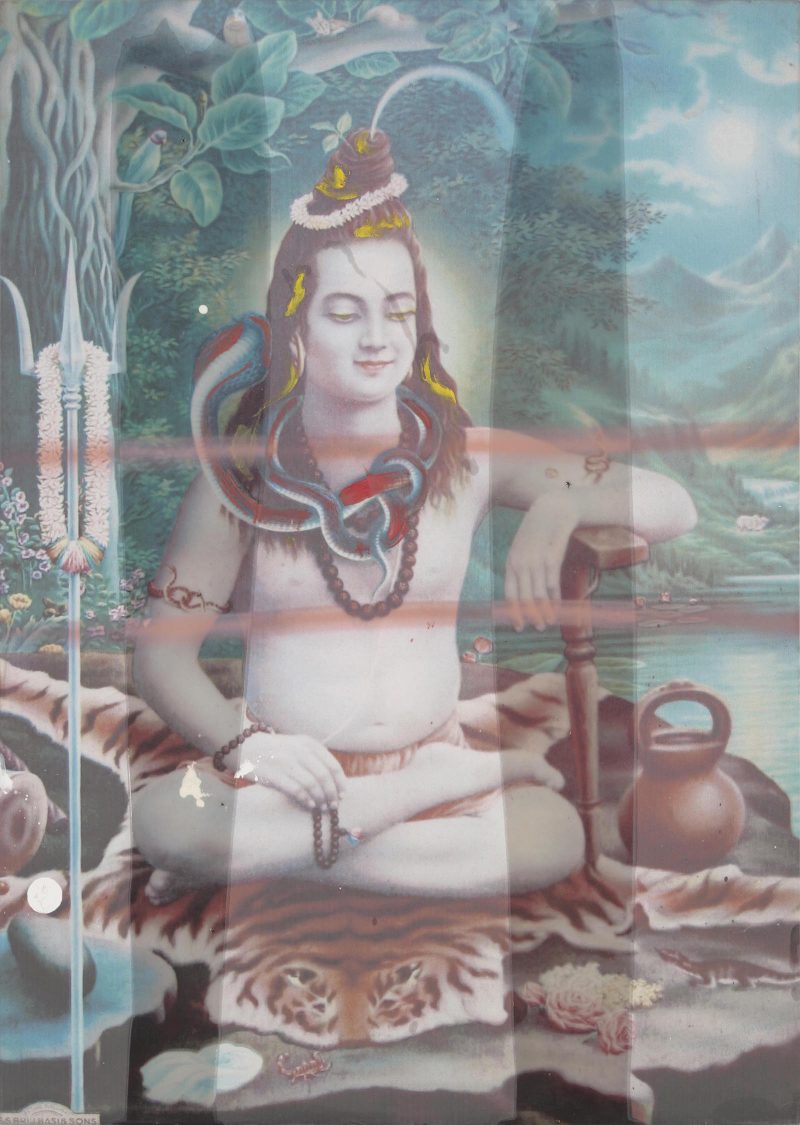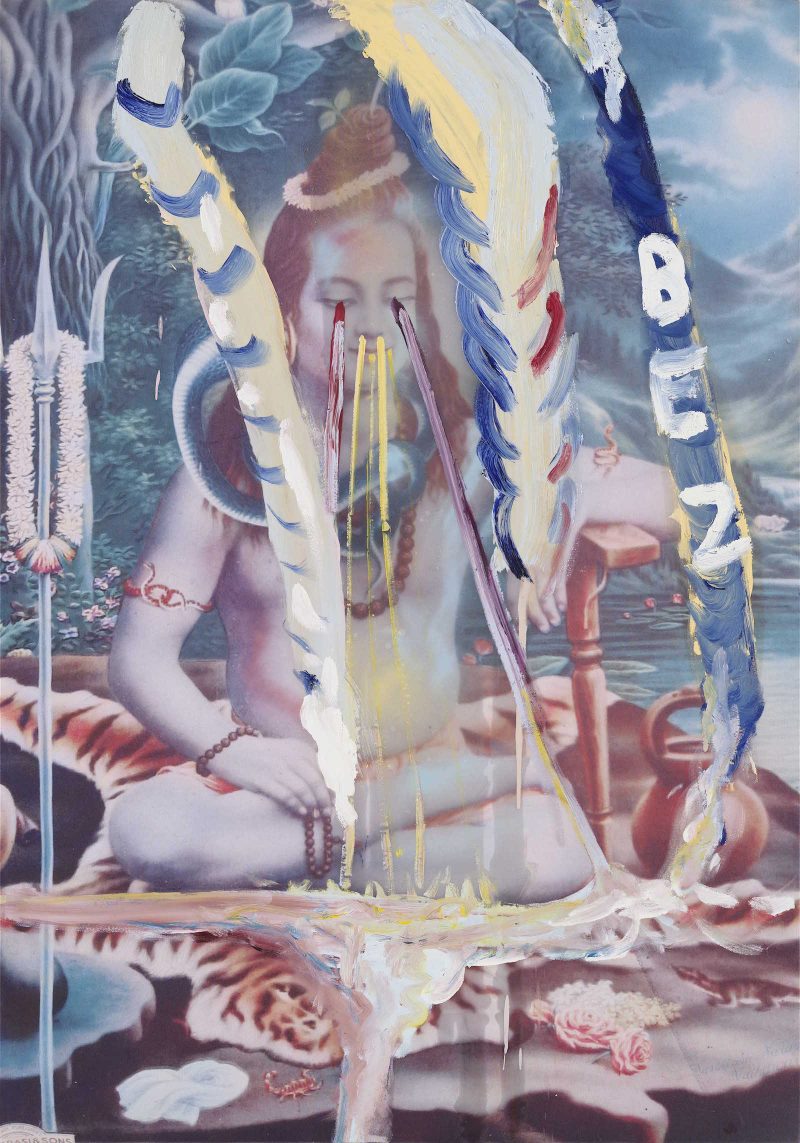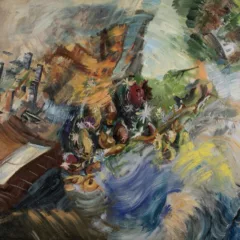
Shiva, a critical member of the Hindu trinity of deities (along with Vishnu and Brahma), has the decisive job of creating, protecting, and transforming the universe. Shiva sports a “third eye,” and is a patron of both yoga and the arts. Which brings us to Julian Schnabel and whether Shiva has a sense of humor and thinks the 65-year old artist is pulling his leg(s).
Julian Schnabel’s transatlantic reincarnation
New York’s 1980s downtown drum major of neo-expressionist painting jumped back into public view in Paris recently with a roomful of a dozen large Shiva paintings, dating from 2007 to 2011. Another gallery, Pace, in New York, just took down a Schnabel exhibit, although New York had no Shivas but instead, new plate paintings.
The Paris exhibition at Daniel Templon (to May 13) endeavors to stitch together a meaningful Schnabel moment across the Atlantic. The show, which tries to capture some enthusiasm for Schnabel’s reincarnation act (his last show at Templon was in 1995), feels tired and uninspired. Is it more than a hopeful echo of the clattering the artist once generated with exhibitions of busted crockery three decades ago?
Destroying the crockery and making some noise
In New York, the Pace show New Plate Paintings (closed March 25 and which I have seen in pictures from the gallery website) featured large works with an array of pink roses in fields of smashed dishes painted in green.** Certainly, from the images, these new plate paintings are a prettier rerun of the 1980s works that were once art world cash cows in the age of Reagan. It’s been reported that some of the older, larger plate paintings have fallen apart, but they did once upon a time own the Zeitgeist, finding their way into collectors’ homes across the planet. This current crop seems destined to generate a modicum of interest largely because Schnabel’s works seem to produce tumult wherever they go.
As the artist evolved from broken plates to other subjects and surfaces, the signal- to-noise ratio the artist generated on the art circuit seemed to irritate people to exasperation. Schnabel’s star rose nonetheless, and his prices followed. But the work I saw in New York throughout the 1980s was always crudely made and layered with seemingly dashed-off renderings and inscrutable texts.
(Above) Randy Kennedy New York Times critic talks with Julian Schnabel and Jeff Koons (April 2017)
For example: ”There is no place on this planet more horrible than a fox farm during pelting season” was the repetitive pivot of one series of large abstract paintings on tarpaulin (Fox Farm Paintings, Pace Gallery, New York, 1989). Really? Well, what about Vietnam? The Sudan? Rwanda, the Amazon, Central America? Indeed, questioning the artist’s stature in the art world is a bit of sport.
When the artist shifted his aesthetic priorities to cinema over the last two decades, the art market that once applauded his boldness, mostly forgot about him.
Gods in a garage sale
Fast forward to Paris, 2017. Julian Schnabel’s 10-year old Shiva Paintings are hung in an intimate and sublime gallery but still manage to have the feel of expensive garage sale items. The works seem faded, tired, out of place and insincere–less a display of genius than a series of mistakes.

The paintings are concocted in this way. The artist prints up images of Shiva lifted from the internet or a book onto polyester canvases which serve as launch pads for his interventions. Smudgy, incoherent lines and splotches of oil paint mixed up with the occasional word–“BEZ” figures prominently–are scrawled over Shiva’s image; the effort is all designed to create a dialogue between East and West. I’m not exactly sure how Schnabel’s marks engender dialog other than disrespect.
The problem is Julian Schnabel is not communicating with the East, and no, his colored scribbles on the images of Shiva do not appear part of a revealing conversation between artist and deity. These are old works and are at best reminders that the art world is a soap opera of colliding ambitions, self-importance, and arrogance.
On a more positive note, Daniel Templon, who has long exhibited many of the high priests of modern and contemporary art–Jim Dine, Eric Fischl, Philip Pearlstein, the late Anthony Caro, and David LaChapelle, among others–is celebrating his 50th anniversary as a gallerist. The Paris dealer’s two spaces are just around the corner from the Centre Pompidou, the famed Paris art mecca which is also celebrating an anniversary: 40 years. If you make it Paris this spring, visit both places.
FOOTNOTE
** As I was gathering images for this article, I sent a simple, ordinary request for images of Julian Schnabel’s Pace show and it came back from the artist’s studio with a request to see a draft of this article for approval. What? Wow!
What would Shiva think?
Julian Schnabel, Galerie Daniel Templon Paris, Shiva Paintings 11 March –13 May, 2017. Impasse Beaubourg 75003 / 30 Rue Beaubourg, 75003 Paris.









